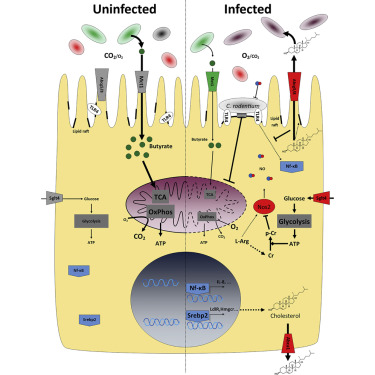当前位置:
X-MOL 学术
›
Cell Metab.
›
论文详情
Our official English website, www.x-mol.net, welcomes your feedback! (Note: you will need to create a separate account there.)
Citrobacter rodentium Subverts ATP Flux and Cholesterol Homeostasis in Intestinal Epithelial Cells In Vivo.
Cell Metabolism ( IF 29.0 ) Pub Date : 2017-Nov-07 , DOI: 10.1016/j.cmet.2017.09.003 Cedric N Berger 1 , Valerie F Crepin 1 , Theodoros I Roumeliotis 2 , James C Wright 2 , Danielle Carson 1 , Meirav Pevsner-Fischer 3 , R Christopher D Furniss 1 , Gordon Dougan 4 , Mally Dori-Bachash 3 , Lu Yu 2 , Abigail Clements 1 , James W Collins 1 , Eran Elinav 3 , Gerald J Larrouy-Maumus 1 , Jyoti S Choudhary 2 , Gad Frankel 1
Cell Metabolism ( IF 29.0 ) Pub Date : 2017-Nov-07 , DOI: 10.1016/j.cmet.2017.09.003 Cedric N Berger 1 , Valerie F Crepin 1 , Theodoros I Roumeliotis 2 , James C Wright 2 , Danielle Carson 1 , Meirav Pevsner-Fischer 3 , R Christopher D Furniss 1 , Gordon Dougan 4 , Mally Dori-Bachash 3 , Lu Yu 2 , Abigail Clements 1 , James W Collins 1 , Eran Elinav 3 , Gerald J Larrouy-Maumus 1 , Jyoti S Choudhary 2 , Gad Frankel 1
Affiliation

|
The intestinal epithelial cells (IECs) that line the gut form a robust line of defense against ingested pathogens. We investigated the impact of infection with the enteric pathogen Citrobacter rodentium on mouse IEC metabolism using global proteomic and targeted metabolomics and lipidomics. The major signatures of the infection were upregulation of the sugar transporter Sglt4, aerobic glycolysis, and production of phosphocreatine, which mobilizes cytosolic energy. In contrast, biogenesis of mitochondrial cardiolipins, essential for ATP production, was inhibited, which coincided with increased levels of mucosal O2 and a reduction in colon-associated anaerobic commensals. In addition, IECs responded to infection by activating Srebp2 and the cholesterol biosynthetic pathway. Unexpectedly, infected IECs also upregulated the cholesterol efflux proteins AbcA1, AbcG8, and ApoA1, resulting in higher levels of fecal cholesterol and a bloom of Proteobacteria. These results suggest that C. rodentium manipulates host metabolism to evade innate immune responses and establish a favorable gut ecosystem.
中文翻译:

Citrobacter rodentium 在体内破坏肠上皮细胞中的 ATP 通量和胆固醇稳态。
排列在肠道内的肠上皮细胞 (IEC) 形成了抵御摄入病原体的强大防线。我们使用全球蛋白质组学和靶向代谢组学和脂质组学研究了肠道病原体柠檬酸杆菌感染对小鼠 IEC 代谢的影响。感染的主要特征是糖转运蛋白 Sglt4 的上调、有氧糖酵解和磷酸肌酸的产生,后者可动员细胞质能量。相反,ATP 产生所必需的线粒体心磷脂的生物合成受到抑制,这与黏膜 O 2水平的增加相吻合并减少结肠相关的厌氧共生菌。此外,IECs 通过激活 Srebp2 和胆固醇生物合成途径对感染作出反应。出乎意料的是,受感染的 IEC 还上调了胆固醇流出蛋白 AbcA1、AbcG8 和 ApoA1,导致粪便胆固醇水平升高和变形杆菌大量繁殖。这些结果表明,C. rodentium 操纵宿主新陈代谢以逃避先天免疫反应并建立有利的肠道生态系统。
更新日期:2017-10-05
中文翻译:

Citrobacter rodentium 在体内破坏肠上皮细胞中的 ATP 通量和胆固醇稳态。
排列在肠道内的肠上皮细胞 (IEC) 形成了抵御摄入病原体的强大防线。我们使用全球蛋白质组学和靶向代谢组学和脂质组学研究了肠道病原体柠檬酸杆菌感染对小鼠 IEC 代谢的影响。感染的主要特征是糖转运蛋白 Sglt4 的上调、有氧糖酵解和磷酸肌酸的产生,后者可动员细胞质能量。相反,ATP 产生所必需的线粒体心磷脂的生物合成受到抑制,这与黏膜 O 2水平的增加相吻合并减少结肠相关的厌氧共生菌。此外,IECs 通过激活 Srebp2 和胆固醇生物合成途径对感染作出反应。出乎意料的是,受感染的 IEC 还上调了胆固醇流出蛋白 AbcA1、AbcG8 和 ApoA1,导致粪便胆固醇水平升高和变形杆菌大量繁殖。这些结果表明,C. rodentium 操纵宿主新陈代谢以逃避先天免疫反应并建立有利的肠道生态系统。



























 京公网安备 11010802027423号
京公网安备 11010802027423号